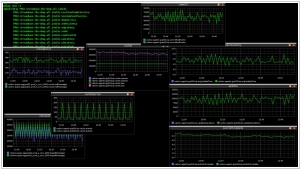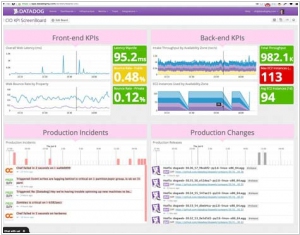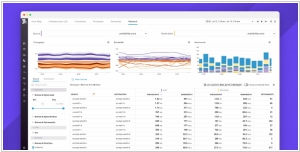Datadog vs Graphite
June 03, 2023 | Author: Michael Stromann
4

Graphite is an enterprise-ready monitoring tool that runs equally well on cheap hardware or Cloud infrastructure. Teams use Graphite to track the performance of their websites, applications, business services, and networked servers. It marked the start of a new generation of monitoring tools, making it easier than ever to store, retrieve, share, and visualize time-series data.
Datadog and Graphite are both popular monitoring and observability tools, but they have distinct differences:
1. Data Collection and Visualization: Datadog provides a comprehensive platform for collecting, aggregating, and visualizing data from various sources, including infrastructure, applications, logs, and more. It offers out-of-the-box integrations with many popular technologies and provides a user-friendly interface for visualizing and analyzing data. Graphite, on the other hand, is a time-series data storage and graphing tool. It focuses primarily on collecting and graphing metrics, providing a flexible and scalable platform for custom data visualization.
2. Features and Functionality: Datadog offers a wide range of features beyond data visualization, including alerting, anomaly detection, log management, APM (Application Performance Monitoring), and more. It provides advanced analytics and machine learning capabilities to help identify and troubleshoot issues. Graphite, on the other hand, focuses primarily on data storage and graphing. It provides a simple and efficient solution for collecting and visualizing time-series data but lacks some of the advanced features found in Datadog.
3. Scalability and Performance: Datadog is a cloud-based solution that offers a highly scalable and distributed architecture. It can handle large volumes of data and provides high-performance data collection and analysis. Graphite, on the other hand, is typically deployed on-premises or in a self-managed infrastructure. Its scalability depends on the underlying hardware and configuration, which may require additional effort to scale and maintain for large-scale deployments.
4. Pricing: Datadog offers a subscription-based pricing model that is based on the number of monitored hosts and desired features. It provides different tiers to cater to the needs of different organizations. Graphite, on the other hand, is an open-source project and is generally free to use. However, organizations using Graphite may need to invest in hardware and infrastructure to set up and maintain their own Graphite cluster.
See also: Top 10 IT Monitoring software
1. Data Collection and Visualization: Datadog provides a comprehensive platform for collecting, aggregating, and visualizing data from various sources, including infrastructure, applications, logs, and more. It offers out-of-the-box integrations with many popular technologies and provides a user-friendly interface for visualizing and analyzing data. Graphite, on the other hand, is a time-series data storage and graphing tool. It focuses primarily on collecting and graphing metrics, providing a flexible and scalable platform for custom data visualization.
2. Features and Functionality: Datadog offers a wide range of features beyond data visualization, including alerting, anomaly detection, log management, APM (Application Performance Monitoring), and more. It provides advanced analytics and machine learning capabilities to help identify and troubleshoot issues. Graphite, on the other hand, focuses primarily on data storage and graphing. It provides a simple and efficient solution for collecting and visualizing time-series data but lacks some of the advanced features found in Datadog.
3. Scalability and Performance: Datadog is a cloud-based solution that offers a highly scalable and distributed architecture. It can handle large volumes of data and provides high-performance data collection and analysis. Graphite, on the other hand, is typically deployed on-premises or in a self-managed infrastructure. Its scalability depends on the underlying hardware and configuration, which may require additional effort to scale and maintain for large-scale deployments.
4. Pricing: Datadog offers a subscription-based pricing model that is based on the number of monitored hosts and desired features. It provides different tiers to cater to the needs of different organizations. Graphite, on the other hand, is an open-source project and is generally free to use. However, organizations using Graphite may need to invest in hardware and infrastructure to set up and maintain their own Graphite cluster.
See also: Top 10 IT Monitoring software
Datadog vs Graphite in our news:
2015. Cloud monitoring service Datadog fetched $31M

Datadog, a platform that enables companies to monitor the performance of their diverse cloud deployments, has secured a new round of Series C funding amounting to $31 million. With notable customers such as Netflix, Spotify, EA, and Mercadolibre, the company has expanded its workforce from 25 employees last year to 75 employees presently. Moreover, Datadog has ambitious plans to double or even triple its headcount in the coming year. While facing competition from rivals like Boundary, Server Density, and Stackdriver (acquired by Google last year), Datadog continues to provide its unique value proposition.



